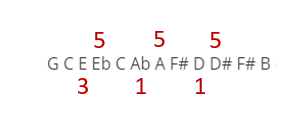Garzone Chromaticism for Improvisation
May 22, 2019There are many ways that you can take chromaticism and incorporate it into your playing. In the last blog, we gave an introduction to chromaticism and how to begin practicing it. In this one, we're going to wrap that all up by providing you with a few approaches that you can use to really start thinking chromatically about your improv and lines - courtesy of George Garzone.
Introduction - 0:32
This lesson is really about covering the concepts put forward by George Garzone, a saxophonist and educator from Boston. He had some great ideas for frameworks relating to chromatic lines -- a tool that you can use to come up with fresh ideas for improvisation. We're going to learn from those today by going over the concepts and coming up with some fresh lines together!
We will have to talk about two concepts: the triadic concept and the chromatic concept.
Triadic Concept - 1:47
The general idea here is to take triads and pair them together by half-steps. This allows you to create what may seem like random lines, but have that chromatic sound.
For example, we'll take the C major triad - C E G. Since we've played G last, G will be our "pivot" into the next triad. We will now go up or down a half-step from G, and create a new triad based on that new note (either G#/Ab or Gb/F#).
We want to avoid repetition and sounding too predictable, so it's a good idea to avoid using the same chord tone for the next triad.
Since G was the 5th of the last triad we played, the new note we choose should not be the 5th of the next triad.
Or, if we do decide to go that route, we could maybe play the notes in a different order - we just played 1 3 5, so next we'll play 5 1 3 instead of 5 3 1 to create some variety.
As an example, in the vlog we've come up with the line:
G C E Eb C Ab A F# D D# F# B
Breaking it down, it was built from these triads:

This line follows by connecting triads where a given note from one triad is a half-step away from another note. We've avoided repeating chord tones twice in a row:

You can think of each third note you play as a sort of pivot point for the next triad. In essence, you string triads together by common tones that are one half step or one half step down.
Practice Tips for Triadic Concept - 5:29
After you've finished working on major triads, move onto minor, diminished, and augmented triads until you're comfortable.
Once you've done that, you can change the accents so that they aren't every 3 notes. Put a metronome up at 40-50 bpm and play quarter notes instead, which will really make your lines sound chromatic, since you're moving away from mirroring the organization of the triads.

It is also important to think about the relationship of the note to the triad (what chord tone are you playing?) as you go through the exercise so that you can really get the most out of it.
If you're not confident about triad spellings, chord tones, or just generally lost in the theory here, I'd suggest checking out this (gentle) introduction to guitar chord theory here!
Likewise, for some extra practice to help with this exercise, here's an intro to jazz guitar arpeggios.
Chromatic Concept - 6:44
The chromatic concept is pretty straightforward by comparison. All you have to do is take a major 3rd interval and play any of the chromatic notes in between. Practice playing those 5 notes without repeating yourself or making any predictable patterns. The goal is to sound chaotic and random.
Now, you can combine the chromatic and triadic approaches. Start by playing the triads as before, and at a certain point, stopping to play a chromatic line as in the chromatic concept. This is sort of the glue that will hold your triads together when done properly.

It helps to be familiar with the chromatic scale for this one, so be sure to check out some extra material if it's shaky for you.
Wrapping it Up - 8:10
...And that's pretty much all there is to it! These things might be aptly described as easy to pick up and difficult to master.
It is a fun new way to frame your thinking around playing lines chromatically, and it's also good to remember that it's just that - a different way to look at things. It doesn't work so well if that's all you play!
Another great takeaway from these exercises is the ear training it provides. When doing the triadic exercises, you must be aware of what chord tones you are playing and when, so it will really get you working on hearing inversions and hearing the relationship between a given note and the triad you're aiming for.
At any point, the next note you play could either be the tonic, third, or fifth of the next triad, and it's up to you to decide which direction to take. To do that, you kind of have to "hear" the triad first. This really helps you hear the chord tones in context.
Lastly, this is an exercise in patience and tolerating outside notes -- essentially, acclimating your ear.
Thanks for tuning into this quick wrap-up on the topic of chromaticism. If you want to see more of this sort of thing...
Please subscribe to the JazzGuitarLessons.net Youtube Channel here!
Until next time!









